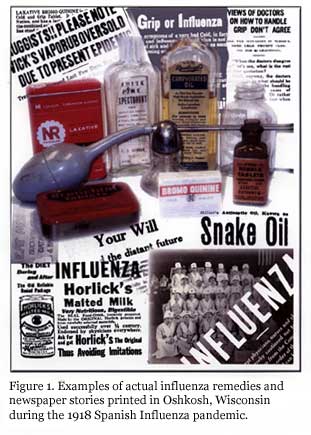
Influenza Drug
Advertisements
Many advertisements appeared in the local press for influenza remedies
(7). They included patent medicines such as Snake Oil, Laxative Bromo-Quinine,
Smoko Tobaccoless Cigarettes, Vick's Vaporub, Hinckle's Tablets, "77"
colds, Kondon's Catarrhal Jelly, Horlick's Malted Milk, Kraft's Preventative
Powder and many others (Figure 1).

The Sears, Roebuck & Company Supply House in Chicago published catalogs that included a Drug Department listing patented medicines against influenza. The Sears catalogs are a vast diary of the times. Such patented products as Dr. Pasteur's Microbe Killer was advertised to prevent La Grippe and all blood disorders if taken once or twice per day. Blackberry brandy was advertised and allowed sale without a license. Catarrh Snuff was guaranteed to give relief against colds/influenza. Other ant-influenza products advertised in the Sears catalog were Special Family Remedies such as Laudanum (a tincture of opium), Essence of Peppermint, Spirits of Camphor, Extract Witch Hazel, and Musterole laxative cold tablets containing acetanilid. Compounds containing acetanilid were used in medicine chiefly as an analgesic or antipyretic.
In 1920, a similar influenza strain appeared in Winnebago County. Talnac,
a patented medicine comprised of beneficial herbs and roots, was the most
advertised drug claimed to prevent the influenza by providing a powerful
resistance to infection (7). Other patent medicines advertised included
Dr. Bell's Pine Tar Honey, Hamlinz Wizard Oil, Cascara Quinine (Hill's
Bromide), "77" for colds, and a Famous Old Recipe for Cough
Syrup that listed Pinex as the major ingredient in the recipe. Pinex is
a highly concentrated compound of Norway pine extract that was known for
its healing effect on membranes.
The Over-the Counter
Treatment Arsenal for Colds and Influenza
Today there are three categories of drugs considered safe and effective
for relieving the symptoms of colds or influenza by the Federal Drug Administration.
These are nasal decongestants, antitussives (cough suppressants), and
expectorants (taken orally and help loosen mucus in order to make coughs
productive). Most over the counter drugs contain two or more active ingredients
in order to relieve multiple symptoms. Hence, often these products are
confusing to consumers. Consumers would benefit from services that counsel
about over the counter medications (15).
Examples of these active ingredients include acetaminophen, aspirin, chlorphiramine
maleate, pseudoephedrine hydrochloride, doxylamine succinate, destromethorphan
HBr, and phenylephrine hydrochloride. In addition, many of the antitussives
contain 5-8% alcohol (14). Prescription cough suppressants may contain
codeine. Very few of these drugs are potentially hazardous if taken in
moderation(15). Certain single over-the-counter medications and combinations
have been shown to reduce cold symptoms in adolescents and adults but
not children(16). Today's home treatment advice is to drink lots of fluids,
rest, and eat chicken soup.
